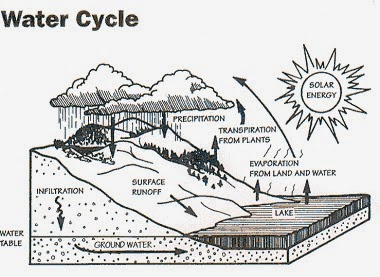VIDEO - The Water cycle
VIDEO - The Water cycle 2
The water cycle, also known as the hydrologic cycle, describes the continuous movement of water on, above and below the surface of the Earth. Water can change states among liquid, vapour, and solid at several places in the water cycle.
The sun, which drives the water cycle, heats water in oceans and seas. Water evaporates as water vapour into the air. Rising air currents take the vapour up into the atmosphere where cooler temperatures cause it to condense into clouds. Air currents move water vapour around the globe, cloud particles fall out of the sky as precipitation. Some precipitation falls as snow or hail.
Most water falls back into the oceans or onto land as rain, where the water flows over the ground as surface runoff. A portion of runoff enters rivers in valleys in the landscape, moving water towards the oceans. Not all runoff flows into rivers, much of it soaks into the ground as infiltration. Some water infiltrates deep into the ground and replenishes aquifers, which store freshwater for long periods of time.
Over time, the water returns to the ocean, where the water cycle started.
